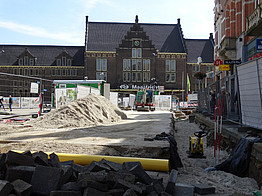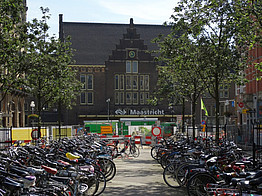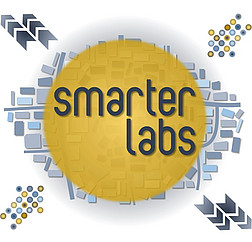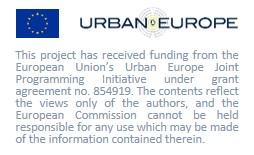Living Lab Experiment Maastricht
The Living Lab experiment in short: The Living Lab experiment in Maastricht consists of a series of initiatives (most notably a series of focus group meetings and a web-based design tool) that engage key stakeholders in co-designing the renovation of the central station area.
Context of experiment: The Living Lab experiment in Maastricht will be conducted as part of the Maastricht Smart City project ‘Smart & Future-proof Station Square’. This multi-year project involves a redesign of the Maastricht Central Station area (overground and underground) including the main square in front of the train station, and aims to address multiple sustainability challenges (e.g. mobility, energy) by making optimal use of innovative, smart solutions. The project invites stakeholders and citizens to become co-creators of the renewed Station Square. Currently, the station and train lines cut the City of Maastricht and the station-area into a west and east-side, with the station mainly opened to the west, cutting-off the east side from the city center. The re-design seeks to re-join the two sides of the city, opening to both sides equally and offering multi-functional services in the Central Station area that go far beyond transportation alone (e.g. shopping, eating and drinking, flexible workplaces, etc.).
Governance context: The Station Square renovation project is led by the City of Maastricht (Department of Sustainability, Mobility and Environment) in collaboration with Antea Group and Maastricht-Bereikbaar (a regional public-private partnership aiming to promote mobility innovation). The policy context of the project is the city’s ambition to make urban mobility more sustainable. The redesign of Maastricht Central Station is a starting point to achieve this. The station is to become a hub in a sustainable, intermodal mobility network, providing train connections to other cities in the Euregion, connections to the electric bus and a (potential) tram system in the city and to bicycle-based mobility (including e-bikes and e-scooters), supported by the latest ICT tools. The redesign of the Station Square is to play a central role in the realization of this mobility hub function and at the same time form a first step towards the goal of Smart City Maastricht.
The Living Lab experiment – aim & organization: The Living Lab experiment is a smart way to deal with the complexities of the project ‘Smart & Future-proof Station Square’. This project is complex both in a technical sense, because it seeks to combine many different functions in a relatively small space and needs to anticipate future uncertainties (such a potential tram line and a potential bicycle tunnel under the rail tracks), and in a social sense, because of the many stakeholders involved, especially travelers of all age and social backgrounds, current local businesses, potential new entrepreneurs, and other users of this area with its new facilities and services.
The Living Lab experiment tackles these complexities and is organized through five phases that broadly reflect the generic steps described in the WP4 description. In Phase 1, participants are selected, and a shared, holistic vision of a smart city is developed (guided by the logical Levels approach). Jointly, the Lab experiment is designed in detail and learning goals, with reference to the shared vision, are defined at both experiment level and stakeholder level. Phase 3 consists of two parallel tracks. The first track uses ICT tools to engage citizens, travelers and local entrepreneurs in the design of the Station Square, most notably a web-based design tool for everyone to create and show his/her own favorite Station Square online. Contributors can comment on each other’s design online, use parts of each other’s’ design and also adapt their own design at a later stage. Experts from the project partners (i.e. policymakers from the City Maastricht, engineers from Grontmij and travel experts from Maastricht-Bereikbaar) will also comment the designs online from their particular expertise. The second track consists of a series of focus-group meetings that bring together key stakeholders: designers, policymakers, travelers, local businesses, citizens etc. This includes citizens that are easily overlooked, especially those that do not match the ‘smart’ profile, such as citizens that are not able to afford or use ICT tools easily. The stakeholder designs posted online can be an input to the focus groups and they can also be shaped by results of it. In Phase 4 the final design is frozen(possibly in different stages). Phase 5 evaluates the effects of the Living Lab on the quality of the (future) renovated station square through interviews and a joint reflection workshop.
The Living Lab experiment fits the strategy of the City of Maastricht to open the redesign process for contributions and initiatives from different stakeholders such as citizens, travelers and local entrepreneurs.
Expected results: The LL experiment effectively builds in additional reflexivity in the station square renovation project through the broader involvement of key stakeholders into a co-design process. This affects the renovation of the station square in a positive way. Most notably it reduces the risk of a socio-technical ‘misfit’ of the new square (i.e. technical solutions that do not fit the demand andconcerns of stakeholders), as well as the risk of excluding certain social groups (especially non-smart groups, by inviting these in the focus groups). It also increases legitimacy of the final design.
Beyond Maastricht, the experiment provides general lessons on anticipation of the risk of socio-technical‘misfit’ and exclusion of non-smart citizens through the design LL experiments, with Special attention for the change of the physical infrastructure.
Partners: City of Maastricht, Antea Group, Maastricht University, Maastricht Bereikbaar




